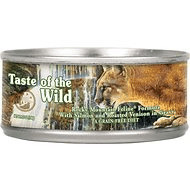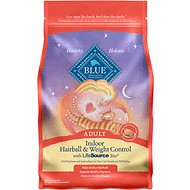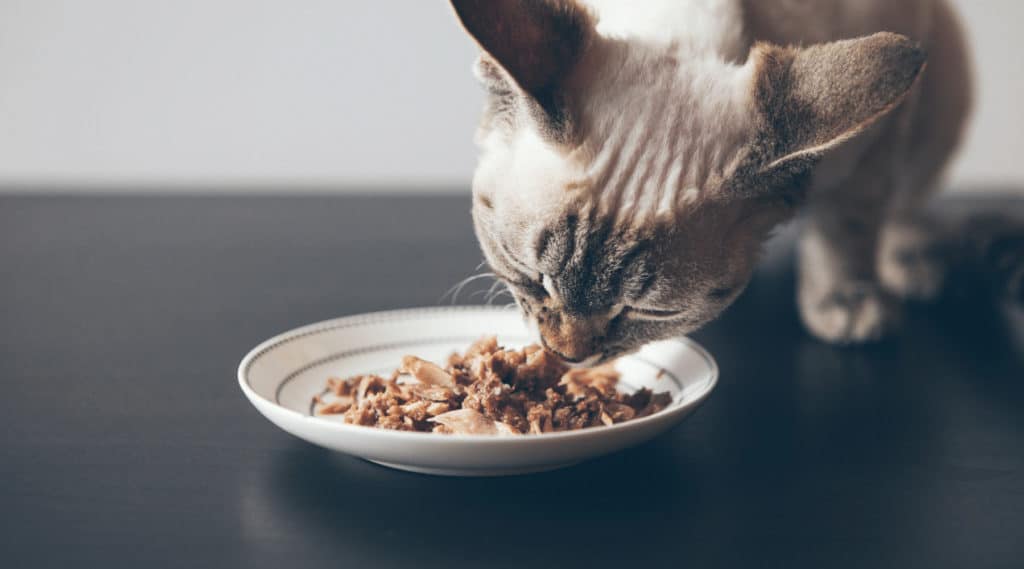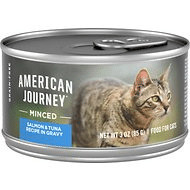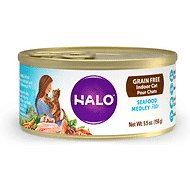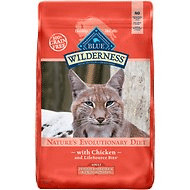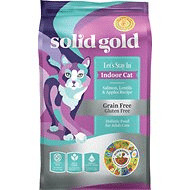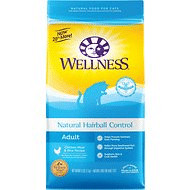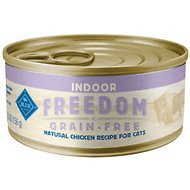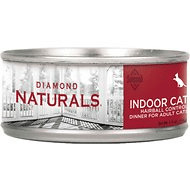Contents
- What is the Best Hairball Control Cat Food?
- What Causes Hairballs in Cats?
- What to Look for in a Good Cat Food for Hairball Prevention
- How Do We Make Our Recommendations?
- The 10 Best Foods to Prevent Hairballs in Cats
- 6 More Top-Rated Cat Foods for Hairball Prevention
- Halo Seafood Medley Pate Grain-Free Indoor Cat Canned Food
- Blue Buffalo Wilderness Chicken Recipe Indoor Hairball Control Grain-Free Dry Food
- Solid Gold Let’s Stay In Salmon, Lentil & Apple Recipe Grain-Free Indoor Dry Cat Food
- Wellness Natural Hairball Control Chicken Meal & Rice Recipe Dry Cat Food
- Blue Buffalo Freedom Indoor Adult Chicken Recipe Grain-Free Canned Cat Food
- Diamond Naturals Indoor Hairball Control Adult Canned Cat Food
- Frequently Asked Questions
Nothing is worse than walking out of your bedroom in the morning and stepping into a wet hairball freshly coughed up in front of your door. Hairballs are a natural occurrence for cats, but they are far from pleasant. As much as you hate stepping in them, however, imagine how much your cat dislikes coughing up wads of matted fur.
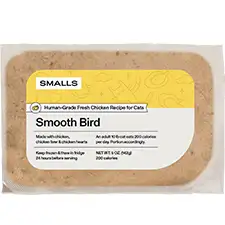
Smalls Human-Grade Ground Bird Fresh Cat Food
- Natural sources of taurine
- High in protein
Hairballs may be natural for cats, but that doesn’t mean they are healthy. If you are worried that your cat might be having too many hairballs, you might want to talk to your veterinarian. Long-haired cats tend to have more hairballs than short-haired cats, but frequent hairballs could also be a sign of an underlying health problem. In addition to talking to your veterinarian, you may also want to switch your cat to a diet formulated for hairball prevention.
In this article, we’ll explore the subject of hairballs in cats to determine what causes them and how changing your cat’s diet might be able to help. You’ll also receive our top 10 picks for the best hairball prevention cat foods with relevant hairball control cat food reviews.
What is the Best Hairball Control Cat Food?
- Small Ground Bird Human-Grade Fresh Cat Food
- Taste of the Wild Rocky Mountain Grain-Free Canned
- American Journey Minced Salmon & Tuna Recipe in Gravy
- Blue Buffalo Indoor Hairball Control Dry Cat Food
- Halo Seafood Medley Pate Grain-Free Indoor Cat Canned Food
- Blue Buffalo Wilderness Chicken Recipe Indoor Hairball Control
- Solid Gold Let’s Stay In Salmon, Lentil & Apple Recipe Grain-Free
- Wellness Natural Hairball Control Chicken Meal & Rice Recipe
- Blue Buffalo Freedom Indoor Adult Chicken Recipe Grain-Free`
- Diamond Naturals Indoor Hairball Control Adult Canned Cat Food
What Causes Hairballs in Cats?
A hairball is little more than a mass of matted hair that accumulates in your cat’s digestive tract. When your cat’s digestive system fails to pass the hair he ingests during grooming, it sometimes accumulates until it gets to the point that your cat has to cough it up. You probably know what a hairball looks like, but there are other symptoms in addition to finding the hairballs themselves that you should look for. Here are some examples:
- Persistent coughing or wheezing
- Gagging, hacking, or retching
- Vomiting up hair
- Loss of appetite
- Lethargy, low energy
- Constipation or diarrhea
Hairballs might vary in appearance from looking like a wet pile of vomit to a fully formed ball of matted hair. If you look closely, you should be able to tell the difference between a hairball and vomit. If your cat is only exhibiting some of the symptoms above and you’re not sure whether it is hairball or vomit, you might need to consider alternate causes. Talk to your veterinarian because there are several things that can easily be confused for hairballs. Here are some of the things you might confuse for hairballs:
- Asthma
- Chemical irritants
- Foreign body
- Change in diet
- Digestive disease
- Feline heartworm
- Infection
Depending on your cat’s symptoms and their severity, your veterinarian might run some tests, or he may simply tell you that hairballs are the issue.
Hairballs are natural and all cats have them from time to time. Just because they are natural, however, doesn’t necessarily mean they are healthy. The occasional hairball is nothing to worry about but if your cat is coughing up several hairballs a week, it might be a problem. Read on to learn what to look for in a cat food for hairball prevention – you might want to make a switch!
What to Look for in a Good Cat Food for Hairball Prevention
Hairballs occur when your cat is unable to pass the hair he ingests during grooming. If you want to reduce the number of hairballs your cat has or their frequency, the solution is to find a way to improve your cat’s digestion so he can harmlessly pass the hair. In many cases, the most obvious solution (and the simplest) is to change what you are feeding your cat.
Here are some of the things we look for in a good hairball prevention cat food:
- High in dietary fiber. Fiber is important for regular digestion in cats as well as people, so switching to a higher fiber recipe might help. Just make sure the fiber content isn’t excessive, because that could worsen the problem with your cat’s digestion.
- Higher moisture content. Cats don’t tend to drink as much water as dogs do, so lack of moisture in their diet could contribute to digestive issues. Wet foods and cat food toppers can increase the moisture content of your cat’s diet without your cat having to drink more water.
- Digestible natural ingredients. Low-quality ingredients and fillers are hard for your cat to digest and they can trigger inflammation or irritation in the digestive tract. To boost your cat’s digestion so he can pass hairballs, choose a recipe made with natural, digestible ingredients.
- No artificial additives. Again, low-quality ingredients will only make your cat’s digestion worse so avoid anything with artificial flavors, colors, or preservatives as main ingredients.
- Prebiotic and probiotic supplements. To further boost your cat’s digestive health, look for a recipe that contains prebiotic fiber and probiotic supplements.
Now that you have a better understanding of your cat’s digestion, you’re ready to start shopping for a hairball prevention cat food! Before you set out on your own, however, we recommend that you consider our top picks. Read on to learn how we make our cat food recommendations.
How Do We Make Our Recommendations?
We would never recommend a product on this site that we wouldn’t feel confident feeding our own cats. This being the case, we understand that pet owners have different budgets and every cat is an individual with unique dietary requirements. As such, we aim to provide a variety of product recommendations, but all of them are reviewed for quality. We understand that cats are obligate carnivores and have a biological need for protein in their diets. We also understand that they require a limited-carbohydrate diet fortified with essential nutrients to ensure nutritional balance.
Here are some of the requirements for a cat food to receive our recommendation:
- A source of high-quality animal protein as the first ingredient
- At least 30% crude protein for kittens and at least 26% for adults
- A minimum of 9% crude fat for kittens and adults
- A balance of omega-3 and omega-6 fatty acids, primarily from animal sources
- A rich blend of nutrients from natural sources and supplements, as needed
- Limited carbohydrate content from digestible sources (like whole grains and veggies)
- No low-quality fillers, by-products, or artificial additives (preservatives, dyes, or flavors)
The 10 Best Foods to Prevent Hairballs in Cats
Now that you have a better understanding of your cat’s nutritional requirements and how choosing the right diet can help with hairballs, you’re ready to start shopping. Here are our top picks for the best foods for hairballs and vomiting:
| Our 2023 Picks: Best Foods for Hairball Prevention | |||
Small Ground Bird Human-Grade Fresh Cat Food
|
CHECK PRICE | ||
Taste Of The Wild Rocky Mountain Grain-Free
|
CHECK PRICE | ||
American Journey Minced Salmon & Tuna Recipe
|
CHECK PRICE | ||
Blue Buffalo Indoor Hairball Control
|
CHECK PRICE | ||
Halo Seafood Medley Pate Grain-Free Indoor Cat
|
CHECK PRICE | ||
Blue Buffalo Wilderness Chicken Recipe Indoor Hairball Control
|
CHECK PRICE | ||
Solid Gold Let’s Stay In Salmon, Lentil & Apple Recipe
|
CHECK PRICE | ||
Wellness Natural Hairball Control Chicken Meal
|
CHECK PRICE | ||
Wellness Natural Hairball Control Chicken Meal
|
CHECK PRICE | ||
Diamond Naturals Indoor Hairball Control
|
CHECK PRICE | ||
Small Ground Bird Human-Grade Fresh Cat Food

- Pros: Rich in protein and moisture, high-quality natural ingredients, prepared and delivered fresh, cooked in small batches, fresh fruits and vegetables, highly digestible
- Cons: Only two recipes to choose from, significantly more expensive than kibble
Taste of the Wild Rocky Mountain Grain-Free Canned Cat Food Recipe
Most Popular Cat Food for Hairball Prevention: When it comes to choosing a new cat food, you’ll find that there are many different options to choose from. If you simply can’t make a choice, you can’t go wrong with a popular brand like Taste of the Wild. We like this Taste of the Wild Rocky Mountain Grain-Free Canned Cat Food Recipe because it is high in moisture and rich in digestible natural ingredients. Not only is this recipe one of the most popular choices, but it is also a great choice in grain free hairball control cat food. This formula features fresh salmon as the main ingredient with chicken liver, fresh chicken, smoked salmon, roasted venison, and ocean fish as supplemental sources of premium animal protein. This recipe is also loaded with healthy fats, providing a rich blend of omega-3 and omega-6 fatty acids to support your cat’s skin and coat health. Plus, it is high in moisture at 82% with 8% protein, 3% fat and 1.5% fiber. Measured as dry matter, this equates to 44% protein, 22% fat, and 8% fiber.
- Pros: Rich in animal protein, highly digestible natural ingredients, multiple sources of animal protein, chelated mineral supplements, rich in fiber for healthy digestion, blend of omega fatty acids
- Cons: May be too high in fiber for some cats, not a single-source protein recipe
American Journey Minced Salmon & Tuna Recipe in Gravy Grain-Free Canned Cat Food
Most Affordable Cat Food for Hairball Prevention: Cat food can be expensive but, in many cases, the more expensive the cat food, the better it is. This certainly isn’t true in all cases, however, and you don’t necessarily need to spend a fortune to get a good cat food. This American Journey Minced Salmon & Tuna Recipe in Gravy Grain-Free Canned Cat Food is an excellent choice and very well-priced. In addition to being a very affordable recipe, this cat food formula is one of the best grain free hairball control cat food options on the market. It may not be specifically formulated as such, but the higher moisture and fiber content will boost your cat’s digestion to help him pass ingested hair. This recipe features fresh salmon as the main ingredient with both fish broth and chicken broth to follow, adding a great deal of moisture. This formula also contains a rich blend of omega-3 and omega-6 fatty acids to support your cat’s skin and coat health. Plus, it is incredibly rich in protein at 9% with 3.5% fat and 1% fiber. Measured as dry matter, this equates to 50% protein, 19% fat, and 5.5% fiber.
- Pros: Incredibly rich in animal protein, highly digestible, high in moisture, rich blend of omega-3 and omega-6 fatty acids, fresh fruits for antioxidants, chelated mineral supplements
- Cons: Main source of fat is plant-based (sunflower oil)
Blue Buffalo Indoor Hairball Control Dry Cat Food
Best Food for Hairballs and Sensitive Stomach: When it comes to reducing hairballs, digestibility is key. This is also an important quality to have in a diet for cats with sensitive stomachs. High-quality, natural ingredients are the most digestible for cats and, unless your cat has an allergy or sensitivity to grains, grain-inclusive diets are highly digestible as long as they are whole grains. Our top pick for the best food for hairballs and sensitive stomach is Blue Buffalo Indoor Hairball Control Dry Cat Food. This formula features fresh chicken and chicken meal as the top two ingredients, both premium sources of digestible animal protein. For carbohydrates, this recipe includes brown rice, barley, and oatmeal with supplemental sources of fiber to help boost your cat’s digestion. It also contains probiotics to help with digestion. Overall, this recipe provides 32% crude protein and 15% fat with 6% fiber at 397 calories per cup.
- Pros: Highly digestible recipe, premium animal proteins, rich in omega fatty acids, supplemented with fiber for digestion, chelated minerals and probiotic supplements
- Cons: Contains some plant protein (pea protein), not a grain-free recipe (some cats may be sensitive)
6 More Top-Rated Cat Foods for Hairball Prevention
If the cat food recipes above don’t seem like a good fit for your cat, don’t worry – there are many other cat foods out there. You don’t even necessarily need to purchase a cat food formulated specifically for hairballs. As long as the food meets your cat’s minimum nutritional requirements and has a higher percentage of fiber and moisture, it should help reduce your cat’s hairball issues. Here are another 6 picks for the best hairball control cat food reviews:
Halo Seafood Medley Pate Grain-Free Indoor Cat Canned Food
This indoor recipe from Halo features real, whole fish with no rendered meat meals. It contains non-GMO whole foods like sweet potatoes, spinach, and carrots to provide a natural source for key nutrients as well as cranberries for urinary tract health. This formula offers complete and balanced nutrition with the help of vitamins and chelated mineral supplements which are bound to protein molecules, increasing their absorption. You’ll also find that this recipe contains plenty of natural meat flavor with no artificial additives, by-products, or fillers. Measured as dry matter, this equates to 45% protein, 13.5% fat, and 4.5% fiber, coming in at just 153 calories per 5.5-ounce can.
Blue Buffalo Wilderness Chicken Recipe Indoor Hairball Control Grain-Free Dry Food
If your cat prefers dry food, this Blue Buffalo Wilderness Chicken Recipe Indoor Hairball Control Grain-Free Dry Food could be a good option. As part of the Wilderness product line, this recipe is grain-free to prevent irritation and inflammation due to food sensitivities – it is also very high in premium animal proteins. This particular recipe features fresh chicken as the main ingredient with chicken meal as a concentrated source of supplemental protein. This recipe does contain pea protein as a main ingredient but also contains several other sources of animal protein. It is highly digestible with help from fresh fruits and vegetables and supplemental fibers, not to mention probiotic supplements. Overall, this recipe provides 38% protein and 16% fat with 5% fiber at 410 calories per cup.
Solid Gold Let’s Stay In Salmon, Lentil & Apple Recipe Grain-Free Indoor Dry Cat Food
To give your cat the benefit of holistic, natural nutrition, consider this Solid Gold Let’s Stay In Salmon, Lentil & Apple Recipe Grain-Free Indoor Dry Cat Food. Formulated for indoor cats, this recipe features premium animal proteins and other highly digestible ingredients and supplemental fiber to boost digestion and reduce hairballs. This recipe starts with fresh salmon as the first ingredient, with salmon meal as a concentrated source of animal protein coming up next. This grain-free recipe relies on digestible carbohydrates like lentils and peas with fresh fruits and vegetables to provide natural sources for key nutrients. This recipe is complete and balanced, fortified with essential vitamins and chelated minerals as well as probiotics for healthy digestion. Overall, it provides a total of 36% crude protein and 16% fat with 8% fiber at 435 calories per cup.
Wellness Natural Hairball Control Chicken Meal & Rice Recipe Dry Cat Food
Another option in dry food for hairball control is this Wellness Natural Hairball Control Chicken Meal & Rice Recipe Dry Cat Food. This formula is designed to prevent hairballs from forming and helps swallowed hair move through the digestive system. It also contains a rich blend of omega fatty acids to support your cat’s skin and coat health. This recipe features chicken meal as the main ingredient which is a concentrated source of animal protein. You’ll also find supplemental protein in the form of fresh chicken and turkey meal as well as several digestible carbohydrates like rice and flaxseed. This recipe is fortified with essential vitamins and chelated minerals to ensure complete and balanced nutrition with probiotic supplements for digestion. It contains 36% protein and 16% fat with 5.75% fiber.
Blue Buffalo Freedom Indoor Adult Chicken Recipe Grain-Free Canned Cat Food
Indoor cats have unique nutritional needs because they don’t tend to be as active as outdoor cats. This Blue Buffalo Freedom Indoor Adult Chicken Recipe Grain-Free Canned Cat Food is a great choice for your indoor cat because it features plenty of premium animal protein with all of the essential nutrients your cat needs for balanced health and optimal wellness. This formula is supplemented with an ideal blend of natural dietary fibers to help move hairballs through the digestive tract and minimize litter box odor. It contains no gluten or grains that might irritate your cat’s digestive tract, and it is completely free from corn, wheat, and soy ingredients as well as by-products and artificial additives. Plus, it contains Blue Buffalo’s LifeSource Bits which are made up of a proprietary blend of vitamins, minerals, and antioxidants. Overall, this recipe provides a dry matter value of 41% protein, 27% fat, and 9% fiber.
Diamond Naturals Indoor Hairball Control Adult Canned Cat Food
Another option in wet food formulated specifically for hairball control is this Diamond Naturals Indoor Hairball Control Adult Canned Cat Food. This formula is packed with high-quality protein, featuring real chicken as a main ingredient. It also contains plenty of insoluble fiber to boost your cat’s digestion with a rich blend of omega fatty acids for skin and coat support. This recipe is fortified with vitamins and minerals as well as taurine, an essential fatty acid, to ensure complete and balanced nutrition for your cat. It also contains no corn or wheat ingredients and is free from by-products and fillers. Overall, this recipe provides a dry matter value of 45% protein, 27% fat, and 9% fiber.
Frequently Asked Questions
- Does wet cat food cause hairballs? – Wet cat food does not cause hairballs. In fact, switching your cat to a wet food diet could serve as a natural hairball remedy for cats. Cats typically have hairballs when they don’t get enough moisture in their diet. Lack of moisture can affect your cat’s digestion and make it more difficult to pass undigested hair. Wet food tends to have a much higher percentage of moisture – usually 78% to 82% versus an average of 10% for dry food. This might help your cat pass hair instead of coughing up hairballs.
- What does hairball control cat food do? – Many cats have issues with hairballs if they are unable to digest the hair they accidentally ingest during grooming. In a cat with a healthy digestive system, most of the hair will pass harmlessly in stool. For cats with sensitive digestion, or in long-haired cats that ingest a larger volume of hair during grooming, the hair might not pass as easily and will form a ball that is then vomited up. Hairball control cat food typically contains higher levels of moisture and dietary fiber to improve your cat’s digestion, helping him pass the ingested hair rather than vomiting it up.
- Why does my cat have so many hairballs? – Hairballs are a natural consequence of your cat swallowing hair. Cats spend a great deal of time grooming themselves, so it is to be expected that your cat will ingest a certain amount of hair. In most cases, however, the cat’s digestive system is able to handle the hair and it will pass harmlessly through the gastrointestinal tract and be excreted in feces. If your cat’s digestion is off-track due to lack of moisture, food allergies or sensitivities, or other digestive issues, however, he may not be able to pass the hair and might have more hairballs as a result.
- Why is my cat throwing up dry food? – Though some cats are picky eaters and tend to only nibble at their food, others get too excited at mealtime and eat their food all at once. If your cat eats too quickly, the dry food could expand when it hits the liquid contents of his stomach. This leads to a natural reflex that causes the cat to throw up. When this happens, the regurgitated food often comes out in a tube-like shape and may look mostly like whole pieces of food. This is the most common reason cats throw up undigested dry food, but vomiting can also be caused by food allergies and sensitivities or other undiagnosed health problems.
- Is a grain-free diet good for hairballs? – Whether or not a cat food recipe is grain-free has little to do with hairballs. Hairballs are formed when your cat ingests hair while grooming himself and is unable to pass all of the hair, forcing him to vomit it up instead. There is some correlation, however, between grain-inclusive diets and vomiting in cats. If your cat is allergic or sensitive to grains, he might throw up more than just hairballs – he might throw up food as well. If your cat has a grain allergy or sensitivity, switching to a grain-free diet may help reduce irritation and inflammation in the digestive tract which will improve digestion and could potentially reduce hairballs as well as a result.
Take what you’ve learned about kitten food here to start shopping on your own, or simply choose one of our top picks reviewed above. We wish you and your kitten well!

